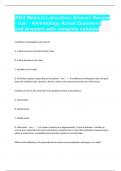The periphe - Study guides, Class notes & Summaries
Looking for the best study guides, study notes and summaries about The periphe? On this page you'll find 109 study documents about The periphe.
Page 3 out of 109 results
Sort by

-
(Top QUALITY 2024/2025 EXAM REVIEW) WGU C107 Module 18 The Peripheral Nervous System, Questions and answers, Rated A+. verified.
- Exam (elaborations) • 4 pages • 2023
-
Available in package deal
-
- $7.99
- + learn more
WGU C107 Module 18 The Peripheral Nervous System, Questions and answers, Rated A+. verified. What causes contralateral motor control? - -Decussation - Nerves crossing over, also called decussation, causes the contralateral or opposite sidedness of motor control. Which best defines cranial nerves? - -Peripheral nerves that emerge from the brain. - These nerves come directly from the brain and regulate functions in the head. Match the following cranial nerve with its role. Oculomotor n...

-
Chapter 44: Care of Patients with Problems of the Peripheral Nervous System Test Bank Medical Surgical Nursing 9th Edition Ignatavicius Workman
- Exam (elaborations) • 8 pages • 2023
-
Available in package deal
-
- $4.01
- + learn more
Test Bank Medical Surgical Nursing 9th Edition Ignatavicius Workman MULTIPLE CHOICE 1. A client is admitted with Guillain-Barr syndrome (GBS). What assessment takes priority? a. Bladder control b. Cognitive perception c. Respiratory system d. Sensory functions ANS: C Clients with GBS have muscle weakness, possibly to the point of paralysis. If respiratory muscles are paralyzed, the client may need mechanical ventilation, so the respiratory system is the priority. The nurse will com...
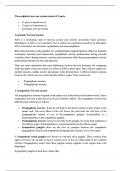
-
The peripheral nervous system notes Questions & 100% Verified Correct Answers with complete solutions (Latest update 2024 2025
- Exam (elaborations) • 8 pages • 2024
-
- $7.99
- + learn more
The peripheral nervous system notes Questions & 100% Verified Correct Answers with complete solutions (Latest update 2024 2025
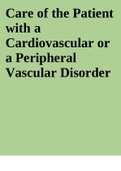
-
Care of the Patient with a Cardiovascular or a Peripheral Vascular Disorder
- Exam (elaborations) • 32 pages • 2022
-
- $12.49
- 1x sold
- + learn more
Care of the Patient with a Cardiovascular or a Peripheral Vascular Disorder. The nurse is aware that the muscle layer of the heart, which is responsible for the heart’s contraction, is the: a. endocardium. b. pericardium. c. mediastinum. d. myocardium. ANS: D The myocardium is the specialized muscle layer that allows the heart to contract. PTS: 1 DIF: Cognitive Level: Comprehension REF: Page 1533 OBJ: 2 TOP: Myocardium KEY: Nursing Process Step: Implementation MSC: NCLEX: Physiolo...
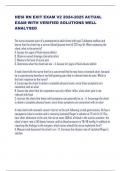
-
HESI RN EXIT EXAM V2 2024-2025 ACTUAL EXAM WITH VERIFIED SOLUTIONS WELL ANALYSED
- Exam (elaborations) • 41 pages • 2024
-
- $18.49
- + learn more
HESI RN EXIT EXAM V ACTUAL EXAM WITH VERIFIED SOLUTIONS WELL ANALYSED The nurse assumes care of a postoperative adult client with type 2 diabetes mellitus and learns that the client has a current blood glucose level of 720 mg/dL. When assessing the client, what is the priority? A. Assess for signs of fluid volume deficit B. Observe wound drainage characteristics C. Measure the level of acute pain D. Determine when the client last ate - A. Assess for signs of fluid volume defici...
2024 Medical Laboratory Science Review - Harr - Hematology Actual Questions and Answers with complete solution
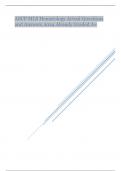
-
ASCP MLS Hematology Actual Questions and Answers 2024 Already Graded A+
- Exam (elaborations) • 65 pages • 2024
-
- $20.49
- + learn more
ASCP MLS Hematology Actual Questions and Answers 2024 Already Graded A+ Variation in red cell size observed on the peripheral smear is described as: A. Anisocytosis B. Hypochromia C. Poikilocytosis D. Pleocytosis - correct answer A. A mature erythrocyte is approximately 7-8 μm in diameter. Variation in normal size is denoted by the term anisocytosis. Hypochromia is a term that indicates increased central pallor in erythrocytes, and poikilocytosis denotes variation in red cell sha...

-
Essential Health Assessment 2nd Edition Thompson Test Bank Chapter 15. Assessing the Peripheral Vascular System and Regional Lymphatic System
- Exam (elaborations) • 39 pages • 2023
- Available in package deal
-
- $14.99
- + learn more
Essential Health Assessment 2nd Edition Thompson Test Bank Chapter 15. Assessing the Peripheral Vascular System and Regional Lymphatic System
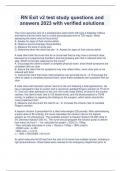
-
RN Exit v2 test study questions and answers 2023 with verified solutions
- Exam (elaborations) • 31 pages • 2023
-
- $12.49
- + learn more
The nurse assumes care of a postoperative adult client with type 2 diabetes mellitus and learns that the client has a current blood glucose level of 720 mg/dL. When assessing the client, what is the priority? A. Assess for signs of fluid volume deficit B. Observe wound drainage characteristics C. Measure the level of acute pain D. Determine when the client last ate - A. Assess for signs of fluid volume deficit A male client tells the nurse that he is concerned that he may have a stomach u...
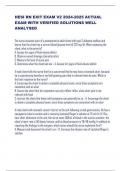
-
HESI RN EXIT EXAM V2 2024-2025 ACTUAL
- Exam (elaborations) • 41 pages • 2024
-
- $18.49
- + learn more
HESI RN EXIT EXAM V ACTUAL EXAM WITH VERIFIED SOLUTIONS WELL ANALYSED The nurse assumes care of a postoperative adult client with type 2 diabetes mellitus and learns that the client has a current blood glucose level of 720 mg/dL. When assessing the client, what is the priority? A. Assess for signs of fluid volume deficit B. Observe wound drainage characteristics C. Measure the level of acute pain D. Determine when the client last ate - A. Assess for signs of fluid volume defici...

How much did you already spend on Stuvia? Imagine there are plenty more of you out there paying for study notes, but this time YOU are the seller. Ka-ching! Discover all about earning on Stuvia



